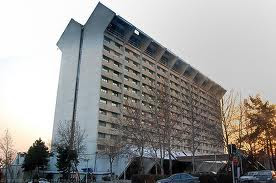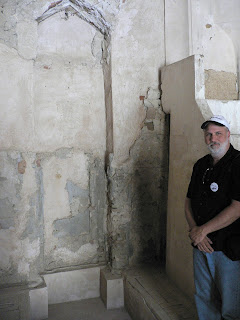More about the last stop on our 2006 trip:
 |
| Intercontinental (now Laleh) Hotel |
Quite unexpectedly, we were asked to come to the swank, originally American-built Laleh Hotel in north Tehran for a meeting with Mr. Esfandiar Rahim Mashaai, Vice President for Cultural Heritage and Tourism [now a close adviser to President Ahmadinezhad]. When I served in the Peace Corps, this hotel (known then as the Intercontinental) was way beyond my price range. Elaine Sciolino, a reporter who arrived in Tehran on the plane carrying Ayatollah Khomeini in from France on the first of February 1979, stayed at the Laleh many times, and talked of it in her book Persian Mirrors: The Elusive Face of Iran:
"Today the Laleh (which means “tulip, “ the symbol of martyrdom), is owned by the Ministry of Islamic Guidance and Culture, which also finds the hospitality business a good way to monitor the comings and goings of Western journalists…We lived through those heady and scary days when rival factions shot up the hotel looking for would-be enemies…the French Rotisserie [restaurant] stayed open even when armed leftist militias used its windows for target practice and hotel employees had to douse the leftists with fire hoses…"
After a short wait for the Vice President’s entourage to arrive at the conference room where we had been seated, Richard Deats, one of our group leaders, a past executive director of FOR and author of books on Gandhi, King and Muriel Lester, made opening remarks on behalf of the group and each of us introduced ourselves briefly.
 |
| Mashaai |
Mr. Mashaai greeted our group, explaining that he had changed his plans in order to meet us. He said that he was supposed to be traveling with the Iranian President and a number of ambassadors, but believed that God wanted him to meet with the group from America because peace and goodwill between our nations is so critically needed.
The subject of the meeting – which lasted over two hours -- was our presence in Iran, the impressions we gathered, the message we sought to convey, and how tourism and other types of exchange might bridge the great divide that yawns between our two peoples. But in the backs of all our minds was the historical and political context in which we spoke. As Santayana said: “Those who forget history are condemned to repeat it.” Our binational history includes certain facts:
- My country is now [during the Bush era], and has been for some years, unpopular, unloved and feared in much of the world – after a long period of being admired and emulated.
- Despite its rhetoric of freedom, my country has supported and encouraged a long string of tyrants and despots around the globe – unsavory people like Ferdinand Marcos, Idi Amin, Manuel Noriega, Nursultan Nazarbayev of Kazakhstan currently and, of course, Saddam Hussein.
- Despite its cherished democratic ideals, my country has helped engineer the fall of democratically-chosen leaders – leaders like Salvador Allende in Chile and Mohammad Mossadegh in Iran – and has failed to endorse the democratic process when it leads to unpalatable results like Hamas’ recent victory.
- My country has done more invading of other countries than any other nation during the past hundred years: the Dominican Republic, Cuba, Grenada, Panama, Afghanistan and Iraq, to name just a few, and has now embraced a “first-strike” option -- “preemptive” war on our own initiative.
- My country has been the nation with the deadliest and most complete arsenal of weapons of mass destruction, the only nation to use nuclear weapons in war, and currently the only one threatening to do so.
- More specifically, the United States has built up a military presence on every one of Iran’s borders – Afghanistan and Pakistan to the east, Saudi Arabia to the south, Iraq and Turkey to the west and Kazakhstan to the north.
On the other side of the coin are actions by the Islamic Republic and its supporters that have helped drive the wedge between our peoples:
- The bloodletting in the early months of the revolution – executions of individuals suspected of various offenses – serious or trivial – after hurried tribunals, stoning of those who transgressed the new rules of orthodoxy, morality or propriety.
- The persecution – legal and non-legal – of Ba’hai’s and other minorities.
- The suppression of dissent in the press and in the universities, and installation of “approved” staff in a variety of different civil institutions.
- The U.S. Embassy takeover and the holding of fifty-two hostages without due process for 444 days and nights, and continuing incidents of the apprehension and prosecution of individuals on trumped-up charges.
- Links between factions in the Islamic Republic and groups in the middle East such as Hezbollah.
Azar Nafisi, who lived in Tehran during the mid-nineties wrote about how things felt in 1995 (in Reading Lolita in Tehran:
"Life in the Islamic Republic was as capricious as the month of April, when short periods of sunshine would suddenly give way to showers and storms. It was unpredictable: the regime would go through cycles of some tolerance, followed by a crackdown."
One has the sense – from observing life on the Iranian streets, conversing with the common people, hearing from religious minority spokespersons and reading the press – that the swings of official mood are not as erratic or as wide these days as they were eleven years ago. Who can say what the future holds, but the country is young and the young are coming of age. It may well be the time for rapprochement between our countries, if it can be done carefully and with great wisdom and sensitivity.
The vice president, when asked a direct question about alternate ways to establish a meaningful dialogue, such as a congressional delegation from America, said that this sort of initiative would be welcome on the Iranian side.
We ended our most interesting day, as guests of the Vice President for dinner (though he had to be elsewhere) at the hotel’s swank rooftop “Tiki” restaurant, in good spirits, if slightly bewildered by the turn of events.



















